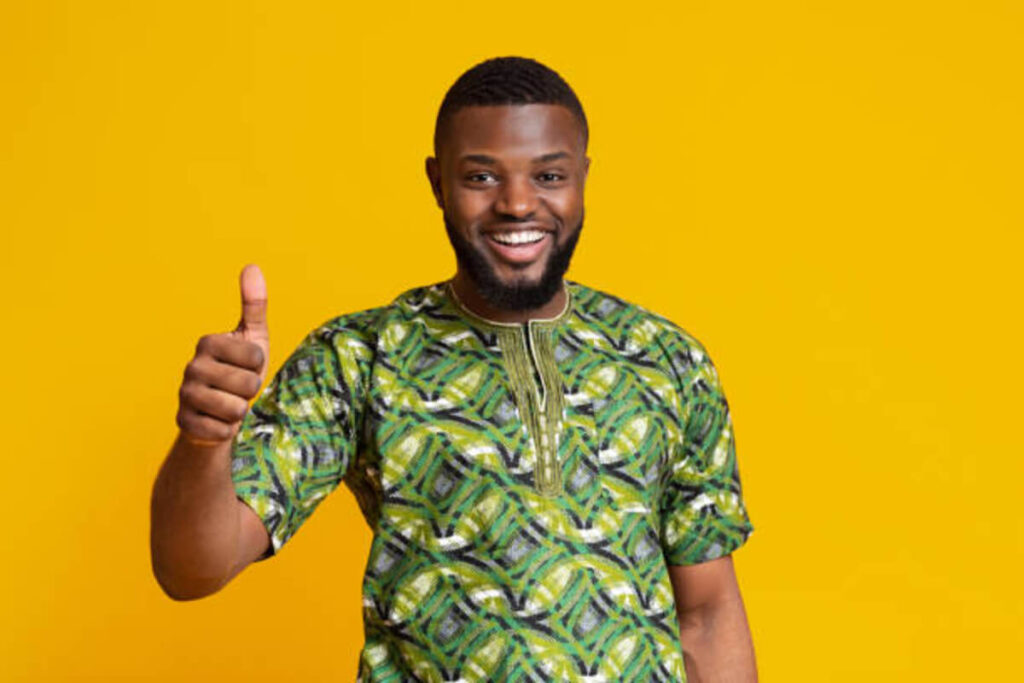Traditional Nigerian dress varies depending on the ethnic group and region of the country. Some common types of traditional dress include the Buba and Sokoto for men and the iro and Buba for women.
The Buba is a loose-fitting blouse, while the Sokoto is a pair of pants. The iro is a wraparound skirt, and the Buba is a blouse. These garments are often made from brightly colored, traditional fabrics such as Ankara, adire, and batik.
Also, check out English Jumpsuit Styles.
In addition, many Nigerian men and women also wear traditional headwraps, jewelry, and other accessories to complete their traditional dress.
The history of traditional Nigerian dress
The history of traditional Nigerian dress is rooted in the country’s diverse cultural heritage, which has been shaped by centuries of invasions, trade, and migration. Before the arrival of Europeans, different ethnic groups in Nigeria had their own unique styles of dress.
During the colonial period, Western clothing and fabrics were introduced to Nigeria and gradually replaced the traditional dress. However, traditional dress continued to be worn in rural areas and at special occasions such as weddings and festivals.
In the post-colonial era, traditional Nigerian dress has experienced a resurgence in popularity, both as a symbol of cultural identity and as a fashion statement. Many young Nigerians have begun to incorporate traditional fabrics and designs into their everyday clothing, and the traditional dress has become more widely accepted in urban areas.
The traditional Nigerian dress has also evolved over the years, with new designs, fabrics, and styles being introduced.
Traditional fabrics such as Ankara, Adire, Aso-oke, Kente, George, and Lace are now being used to create a fusion of traditional and contemporary styles, making them more appealing to the younger generation.
In recent years, traditional Nigerian dress has also gained international recognition, with designers and fashion houses showcasing their own interpretations of traditional Nigerian styles at global fashion events. This has helped to further popularize traditional Nigerian dress and has also helped to promote the country’s rich cultural heritage on the global stage.
The different types of traditional fabrics
In Nigeria, traditional fabrics are an important aspect of traditional dress. Some of the most popular traditional fabrics used in Nigeria include:
Ankara
This is a cotton-based fabric that is often wax-printed with bold, colorful designs. It is commonly used to make clothing such as dresses, skirts, and blouses.
Adire
This is a traditional indigo-dyed fabric that is made by the Yoruba people of Nigeria. It is often hand-painted or tie-dyed with intricate designs.
Aso-oke
This is a hand-woven fabric that is made by the Yoruba people of Nigeria. It is typically made from cotton or silk and is used to make clothing such as traditional headwraps, skirts, and blouses.
Kente
This is a brightly colored, hand-woven fabric that is made by the Ashanti people of Ghana and widely used in Nigeria as well.
In addition to these traditional fabrics, there are also several traditional Nigerian dresses that are worn by both men and women. These include:
- Agbada: This is a traditional men’s dress that consists of a long, flowing robe and a matching pair of pants. It is often worn for special occasions such as weddings and festivals.
- Iro and Buba: This is a traditional women’s dress that consists of a wraparound skirt (iro) and a blouse (Buba). It is often worn with a headwrap and other traditional accessories.
- Buba and Sokoto: This is a traditional men’s dress that consists of a loose-fitting blouse (Buba) and a pair of pants (Sokoto). It is often worn with a headwrap and other traditional accessories.
These are some examples of traditional fabrics and dresses worn in Nigeria, but there are many more traditional garments and fabrics that are specific to different ethnic groups and regions within the country.
Also, check out Agriculture in Nigeria and its Benefits.
How to wear traditional Nigerian dress
Wearing traditional Nigerian dress can be a stylish and meaningful way to celebrate the country’s rich cultural heritage. Here are a few tips on how to wear traditional Nigerian dress:
- Choose the right traditional dress: There are many different traditional Nigerian dresses to choose from, each with its own unique style and meaning. Some popular traditional dresses include the agbada, iro and Buba, and Buba and Sokoto. Choose a dress that feels comfortable and that you feel confident wearing.
- Pair with traditional accessories: To complete the traditional look, pair your dress with traditional accessories such as a headwrap, jewelry, and shoes. These accessories can be made from traditional fabrics such as Ankara, Adire, Aso-oke, and Kente.
- Wear appropriate undergarments: Some traditional Nigerian dresses are worn with a wrapper, which is a type of skirt or shawl that is wrapped around the waist. If your dress requires a wrapper, make sure to wear appropriate undergarments to ensure that the wrapper fits comfortably and stays in place.
- Choose the right occasion: Traditional Nigerian dress is typically worn at special occasions such as weddings, festivals, and ceremonies. Be mindful of the occasion and dress appropriately.
- Be mindful of the culture: Traditional Nigerian dress is an expression of culture and tradition. Be respectful of the culture and the people who wear these garments.
- Accessorize with traditional jewelry: Traditional Nigerian jewelry such as coral beads, cowrie shells, and metal works like bronze, copper, and iron are popular choices to complement the traditional dress.
- Embrace the colors: Traditional Nigerian dress is known for its bright, bold colors and prints. Don’t be afraid to embrace these colors and let them add a pop of color to your outfit.
- Pay attention to the details: Traditional Nigerian dress often features intricate embroidery, beading, and other decorative details. Take the time to appreciate these details and let them add an extra level of elegance to your outfit.
- Be creative: Traditional Nigerian dress is a versatile form of clothing, you can mix and match different styles and fabrics to create a unique and modern look.
- Confidence is key: The most important aspect of wearing traditional Nigerian dress is confidence. If you feel comfortable and confident in your outfit, you will radiate that confidence and make a bold statement.
By following these tips, you can wear traditional Nigerian dress with confidence and style, and help to celebrate and promote the country’s rich cultural heritage.
Final Notes on Traditional Fabrics and Dresses in Nigeria
In conclusion, traditional Nigerian dress is an important aspect of the country’s cultural heritage, and it has experienced a resurgence in popularity in recent years.
Traditional fabrics such as Ankara, Adire, Aso-oke, Kente, George, and Lace are widely used, and traditional dresses such as the agbada, iro, and Buba, and Buba and Sokoto are commonly worn.
To wear traditional Nigerian dress with style and confidence, it is important to choose the right dress, pair it with traditional accessories, wear appropriate undergarments, choose the right occasion, and be respectful of the culture.
With the right approach, traditional Nigerian dress can be a stylish and meaningful way to celebrate the country’s rich cultural heritage.








Pingback: Men's Palm Slippers | EntsToday